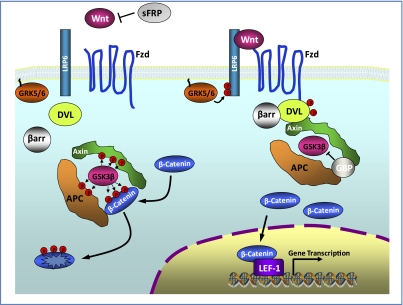Fig. 2.
Wnt signaling pathway. In the absence of Wnt, cytosolic β-catenin is phosphorylated by GSK3β. Adenomatous polyposis coli (APC) and axin complex with GSK3β and β-catenin to enhance this destruction process. Phosphorylated β-catenin is recognized by the ubiquitin ligase βTrCP, ubiquinated, and degraded. Hence the Wnt signaling is in an “off” state (left). Wnts bind both Frizzled and LRP5/6 receptors to initiate GRK5/6-mediated LRP phosphorylation as well as dishevelled/β-arrestin-mediated Frizzled internalization. Dishevelled membrane translocation and phosphorylation leads to dissociation of the axin/APC/GSK3β destruction complex. Hence β-catenin phosphorylation is inhibited and it accumulates in the cytosol. The accumulated cytosolic β-catenin translocates into the nucleus to bind to LEF/TCFs cotranscription factors, which results in the Wnt-responsive gene transcription (right). Fzd, Frizzled; GBP, GSK3β binding proteins; DVL, Dishevelled; βarr, β-arrestin; GRK, G protein-coupled receptor kinase.

